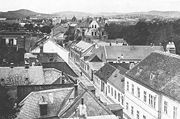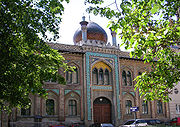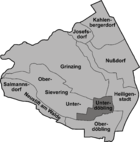
Unterdöbling
Encyclopedia
Unterdöbling was an independent municipality
until 1892 and is today a part of Döbling
, the 19th district of Vienna
. It is also one of the 89 Katastralgemeinde
n.
. The border between Unterdöbling and Oberdöbling is largely determined by the Krottenbach, a stream which today serves as a canal. The medieval town centre lay in a dip by the stream, where nowadays the Rudolfinergasse and the Nußwaldgasse (which used to be called the Herrengasse
) lie. In more recent times, settlement took place on the plateau that rises slowly to the west and to the north towards the Kahlenberg
. Unterdöbling’s southern border runs alongside Oberdöbling, in the west it borders on Untersievering
and in the north on Grinzing
as well as on parts of Heiligenstadt
. The eastern border is marked by a road leading from Oberdöbling via the Hohe Warte
to Heiligenstadt
.
 Döbling is mentioned for the first time in an official document in 114
Döbling is mentioned for the first time in an official document in 114
as de Teopilic. This name is of Slavic origin; toplica either means “marshy water” and refers to the settlement’s location by the Krottenbach or derives from the Old Slavic term for a “warm creek”. Later usage includes spellings such as Toblich, Töbling and Tepling.
Originally, Unterdöbling was known as Chrottendorf because of its location by the Krottenbach. The name Unterdöbling was first used in the 15th century.
was however hit even harder. In 1783, there were 300 inhabitants in Unterdöbling, and around 1800, Unterdöbling still had just one street. By 1828, the number of inhabitants had risen to around 500 and the number of houses to 53, but the population shrank again in the following years. In 1835, there were just 400 inhabitants left. Thereafter though, growth paralleled that in Oberdöbling. In 1853, 941 people were living in Unterdöbling; in 1890 there were 2,074 people in 170 houses. In 1892, Unterdöbling and Oberdöbling
, along with the surrounding suburbs of Grinzing
, the Kahlenbergerdorf
, Nußdorf
, Heiligenstadt
, Sievering
and Josefsdorf
, were turned into the 19th district of Vienna, Döbling
.
In the post-war years of the 1950s, the Krim, a part of Unterdöbling, experienced rapid growth. This once infamous and poverty-stricken quarter was turned into an upmarket residential area with its own parish church.
The Zacherl insecticide factory
in the Nußwaldgasse developed into Unterdöbling's most important industrial enterprise. Johann Zacherl had been importing insecticide made of pyrethrum
from Tiflis since 1842, and in 1870, he began production in Unterdöbling. His Zacherlin product was sold in his own shops all over the world. Karl Mayreder
’s reconstruction of the factory in the form of a mosque
gave Unterdöbling the most unusual factory building in all of Vienna. Zacherl’s heirs struggled with the growth of the chemical industry after World War I
; in 1933, they were also producing ski binding
s. The Zacherl factory closed in the 1950s.
 Johann Zacherl’s Zacherlfabrik
Johann Zacherl’s Zacherlfabrik
, designed in an oriental style and resembling a mosque, is a unique construction. Another important building is the Döbling Carmelite Nunnery
in the Silbergasse and its Kirche Hl. Familie (Holy Family
Church). There are also several former vintner
’s houses in Unterdöbling. The local cemetery, which held the graves of Johann Strauß the Elder und Joseph Lanner, was also in Unterdöbling, but it was closed in 1927. Although their remains were moved to Vienna’s Zentralfriedhof
, their graves became a feature of the Strauß-Lanner-Park, which was established on the site of the former cemetery.
Municipality
A municipality is essentially an urban administrative division having corporate status and usually powers of self-government. It can also be used to mean the governing body of a municipality. A municipality is a general-purpose administrative subdivision, as opposed to a special-purpose district...
until 1892 and is today a part of Döbling
Döbling
Döbling is the 19th District in the city of Vienna, Austria . It is located on the north end from the central districts, north of the districts Alsergrund and Währing...
, the 19th district of Vienna
Vienna
Vienna is the capital and largest city of the Republic of Austria and one of the nine states of Austria. Vienna is Austria's primary city, with a population of about 1.723 million , and is by far the largest city in Austria, as well as its cultural, economic, and political centre...
. It is also one of the 89 Katastralgemeinde
Katastralgemeinde
A Katastralgemeinde , a German word , is a cadastral subdivision of municipalities in the nations of Austria, Croatia, the Czech Republic, Slovakia, the Italian provinces of South Tyrol, Trentino, Gorizia, Trieste, and in Slovenia.A cadastral community records property ownership in a cadastre,...
n.
| Unterdöbling | |
|---|---|
| Coat of arms | Map |
 |
 |
Location: 48°14′39"N 16°21′5"E |
|
Geography
The Katastralgemeinde Unterdöbling lies in Döbling, the 19th district of Vienna, to the north of OberdöblingOberdöbling
Oberdöbling was an independent municipality until 1892 and is today a part of Döbling, the 19th district of Vienna. It is also one of the 89 Katastralgemeinden.- Geography :...
. The border between Unterdöbling and Oberdöbling is largely determined by the Krottenbach, a stream which today serves as a canal. The medieval town centre lay in a dip by the stream, where nowadays the Rudolfinergasse and the Nußwaldgasse (which used to be called the Herrengasse
Herrengasse
The Herrengasse is a street in Vienna, located in the first district Innere Stadt.-History:...
) lie. In more recent times, settlement took place on the plateau that rises slowly to the west and to the north towards the Kahlenberg
Kahlenberg
Kahlenberg is a mountain located in the 19th District within Vienna, Austria .-General:Kahlenberg lies in the Wienerwald and is one of the most popular destinations for day-trips from Vienna, offering a view over the entire city. Parts of Lower Austria can also be seen from Stefaniewarte at the...
. Unterdöbling’s southern border runs alongside Oberdöbling, in the west it borders on Untersievering
Sievering
Sievering is a suburb of Vienna and part of Döbling, the 19th district of Vienna. Sievering was created in 1892 out of the two erstwhile independent suburbs Untersievering and Obersievering. These still exist as Katastralgemeinden.- Geography :...
and in the north on Grinzing
Grinzing
Grinzing was an independent municipality until 1892 and is today a part of Döbling, the 19th district of Vienna.- Geography :- Location :...
as well as on parts of Heiligenstadt
Heiligenstadt, Vienna
Heiligenstadt was an independent municipality until 1892 and is today a part of Döbling, the 19th district of Vienna.Heiligenstadt is one of the 10 municipalities in the Döbling District.- Geography :...
. The eastern border is marked by a road leading from Oberdöbling via the Hohe Warte
Hohe Warte, Vienna
The Hohe Warte is a hill in the 19th district of the city of Vienna, Döbling between Heiligenstadt and Unterdöbling. There is also a street with the same name. In the 19th century, a number of villas were built on the Hohe Warte because it offered good views of the surrounding areas...
to Heiligenstadt
Heiligenstadt
Heiligenstadt may refer to several places:*Heilbad Heiligenstadt, Thuringia, Germany*Heiligenstadt i.OFr. , Bamberg , Bavaria, Germany*Heiligenstadt, Vienna, Austria*Heiligenstadt, part of Neuhaus in Kärnten, Carinthia, Austria...
.
The origin of the name Döbling

114
Year 114 was a common year starting on Sunday of the Julian calendar. At the time, it was known as the Year of the Consulship of Hasta and Vopiscus...
as de Teopilic. This name is of Slavic origin; toplica either means “marshy water” and refers to the settlement’s location by the Krottenbach or derives from the Old Slavic term for a “warm creek”. Later usage includes spellings such as Toblich, Töbling and Tepling.
Originally, Unterdöbling was known as Chrottendorf because of its location by the Krottenbach. The name Unterdöbling was first used in the 15th century.
Unterdöbling from the Middle Ages to the 16th century
Medieval Unterdöbling was inhabited by farmers who were largely reliant on their own produce. They produced wine for sale, but also planted cereals for this purpose and produced fruit, vegetables and milk products. In the 12th century, the nobles derer von Topolic owned Döbling, later it was the property of the Dominican monastery in Tulln. It is mentioned in a document from 1310 as the village of the ladies of Tulln. As time progressed, separate villages evolved, divided from one another by the Krottenbach. The separation of the two settlements was recorded in an official document for the first time in 1591.Unterdöbling since the 16th century
A village seal dating from 1688 has been preserved. It depicts Saint James with the inscription Sigil der gemain Under Thöbling 1688 (Seal of the municipality Under Thöbling 1688). Unterdöbling’s development was impeded by a lack of available land and remained behind that of Oberdöbling. By the start of the 18th century, Unterdöbling was nonetheless still around a third larger than Oberdöbling, but the plague hit Unterdöbling much harder than its southern neighbour in 1713. More than half of all houses were infected and 52 people died. Nearby SieveringSievering
Sievering is a suburb of Vienna and part of Döbling, the 19th district of Vienna. Sievering was created in 1892 out of the two erstwhile independent suburbs Untersievering and Obersievering. These still exist as Katastralgemeinden.- Geography :...
was however hit even harder. In 1783, there were 300 inhabitants in Unterdöbling, and around 1800, Unterdöbling still had just one street. By 1828, the number of inhabitants had risen to around 500 and the number of houses to 53, but the population shrank again in the following years. In 1835, there were just 400 inhabitants left. Thereafter though, growth paralleled that in Oberdöbling. In 1853, 941 people were living in Unterdöbling; in 1890 there were 2,074 people in 170 houses. In 1892, Unterdöbling and Oberdöbling
Oberdöbling
Oberdöbling was an independent municipality until 1892 and is today a part of Döbling, the 19th district of Vienna. It is also one of the 89 Katastralgemeinden.- Geography :...
, along with the surrounding suburbs of Grinzing
Grinzing
Grinzing was an independent municipality until 1892 and is today a part of Döbling, the 19th district of Vienna.- Geography :- Location :...
, the Kahlenbergerdorf
Kahlenbergerdorf
Kahlenbergerdorf was an independent municipality until 1892 and is today a part of Döbling, the 19th district of Vienna. It is also one of the 89 Katastralgemeinden.- Location :...
, Nußdorf
Nußdorf, Vienna
Nußdorf was a separate municipality until 1892 and is today a suburb of Vienna in the 19th district of Döbling.- Location :Nußdorf lies on both banks of the Nußbach , where the brook meets the Danube Canal...
, Heiligenstadt
Heiligenstadt, Vienna
Heiligenstadt was an independent municipality until 1892 and is today a part of Döbling, the 19th district of Vienna.Heiligenstadt is one of the 10 municipalities in the Döbling District.- Geography :...
, Sievering
Sievering
Sievering is a suburb of Vienna and part of Döbling, the 19th district of Vienna. Sievering was created in 1892 out of the two erstwhile independent suburbs Untersievering and Obersievering. These still exist as Katastralgemeinden.- Geography :...
and Josefsdorf
Josefsdorf
Josefsdorf was an independent municipality until 1892 and is today a part of Döbling, the 19th district of Vienna. It is also one of the 89 Katastralgemeinden.- Geography :...
, were turned into the 19th district of Vienna, Döbling
Döbling
Döbling is the 19th District in the city of Vienna, Austria . It is located on the north end from the central districts, north of the districts Alsergrund and Währing...
.
In the post-war years of the 1950s, the Krim, a part of Unterdöbling, experienced rapid growth. This once infamous and poverty-stricken quarter was turned into an upmarket residential area with its own parish church.
Economy
Viticulture still had a prominent place in Unterdöbling's economy in 1826. Almost half of the available land was covered with vineyards. Agriculture occupied a further quarter of the land and pasture made up around one fifth.The Zacherl insecticide factory
Zacherlfabrik
The Zacherl factory is a former factory in the 19th district of Vienna, Döbling. It was built in an oriental style.- History :...
in the Nußwaldgasse developed into Unterdöbling's most important industrial enterprise. Johann Zacherl had been importing insecticide made of pyrethrum
Pyrethrum
Pyrethrum refers to several Old World plants of the genus Chrysanthemum which are cultivated as ornamentals for their showy flower heads. Pyrethrum is also the name of a natural insecticide made from the dried flower heads of C. cinerariifolium and C...
from Tiflis since 1842, and in 1870, he began production in Unterdöbling. His Zacherlin product was sold in his own shops all over the world. Karl Mayreder
Karl Mayreder
Karl Mayreder was an Austrian architect.- Life and work :Karl Mayreder was born the son of hotelier Leopold Mayreder and his wife Henriette Mayreder...
’s reconstruction of the factory in the form of a mosque
Mosque
A mosque is a place of worship for followers of Islam. The word is likely to have entered the English language through French , from Portuguese , from Spanish , and from Berber , ultimately originating in — . The Arabic word masjid literally means a place of prostration...
gave Unterdöbling the most unusual factory building in all of Vienna. Zacherl’s heirs struggled with the growth of the chemical industry after World War I
World War I
World War I , which was predominantly called the World War or the Great War from its occurrence until 1939, and the First World War or World War I thereafter, was a major war centred in Europe that began on 28 July 1914 and lasted until 11 November 1918...
; in 1933, they were also producing ski binding
Ski binding
A ski binding is an attachment which anchors a ski boot to the ski. There are different types of bindings for different types of skiing.-Universal designs:...
s. The Zacherl factory closed in the 1950s.
Sights

Zacherlfabrik
The Zacherl factory is a former factory in the 19th district of Vienna, Döbling. It was built in an oriental style.- History :...
, designed in an oriental style and resembling a mosque, is a unique construction. Another important building is the Döbling Carmelite Nunnery
Döbling Carmelite Nunnery
The Döbling Carmelite Monastery is a monastery belonging to the Teresian Carmelites, a reformed branch of the Carmelites that arose out of the reform of the Carmelite Order by two Spanish saints, St. Teresa of Ávila and St. John of the Cross; the Teresian Carmelites thus belong to the Discalced...
in the Silbergasse and its Kirche Hl. Familie (Holy Family
Holy Family
The Holy Family consists of the Child Jesus, the Virgin Mary, and Saint Joseph.The Feast of the Holy Family is a liturgical celebration in the Roman Catholic Church in honor of Jesus of Nazareth, his mother, the Blessed Virgin Mary, and his foster father, Saint Joseph, as a family...
Church). There are also several former vintner
Vintner
A vintner is a wine merchant. You pronounce it like this In some modern use, in particular in American English, the term is alsoused as a synonym for winemaker....
’s houses in Unterdöbling. The local cemetery, which held the graves of Johann Strauß the Elder und Joseph Lanner, was also in Unterdöbling, but it was closed in 1927. Although their remains were moved to Vienna’s Zentralfriedhof
Zentralfriedhof
The Zentralfriedhof is one of the largest cemeteries in the world, largest by number of interred in Europe and most famous cemetery among Vienna's nearly 50 cemeteries.-Name and location:...
, their graves became a feature of the Strauß-Lanner-Park, which was established on the site of the former cemetery.

